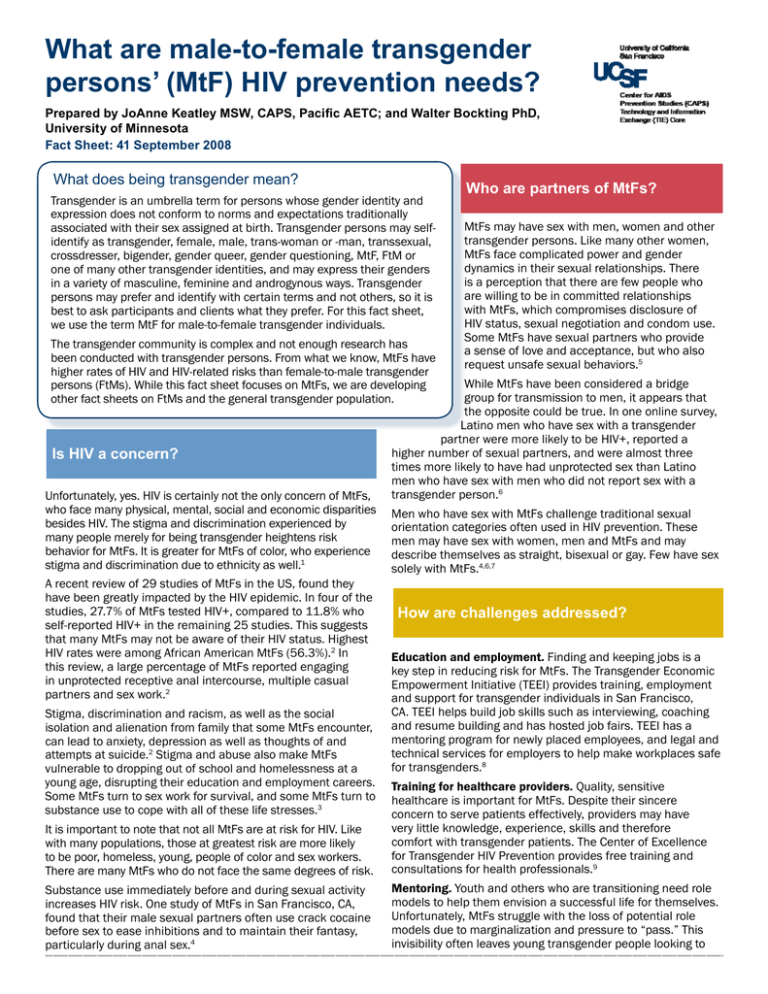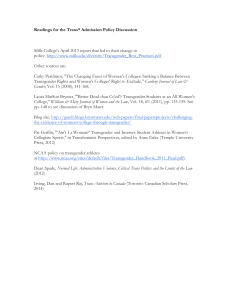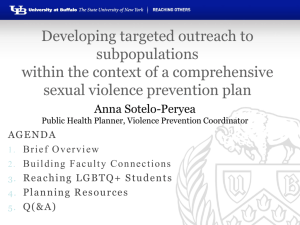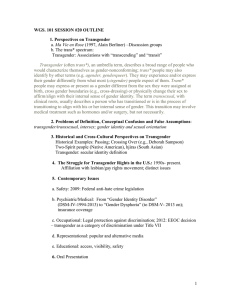
What are male-to-female transgender
persons’ (MtF) HIV prevention needs?
Prepared by JoAnne Keatley MSW, CAPS, Pacific AETC; and Walter Bockting PhD,
University of Minnesota
Fact Sheet: 41 September 2008
What does being transgender mean?
Transgender is an umbrella term for persons whose gender identity and
expression does not conform to norms and expectations traditionally
associated with their sex assigned at birth. Transgender persons may selfidentify as transgender, female, male, trans-woman or -man, transsexual,
crossdresser, bigender, gender queer, gender questioning, MtF, FtM or
one of many other transgender identities, and may express their genders
in a variety of masculine, feminine and androgynous ways. Transgender
persons may prefer and identify with certain terms and not others, so it is
best to ask participants and clients what they prefer. For this fact sheet,
we use the term MtF for male-to-female transgender individuals.
The transgender community is complex and not enough research has
been conducted with transgender persons. From what we know, MtFs have
higher rates of HIV and HIV-related risks than female-to-male transgender
persons (FtMs). While this fact sheet focuses on MtFs, we are developing
other fact sheets on FtMs and the general transgender population.
Is HIV a concern?
Unfortunately, yes. HIV is certainly not the only concern of MtFs,
who face many physical, mental, social and economic disparities
besides HIV. The stigma and discrimination experienced by
many people merely for being transgender heightens risk
behavior for MtFs. It is greater for MtFs of color, who experience
stigma and discrimination due to ethnicity as well.1
A recent review of 29 studies of MtFs in the US, found they
have been greatly impacted by the HIV epidemic. In four of the
studies, 27.7% of MtFs tested HIV+, compared to 11.8% who
self-reported HIV+ in the remaining 25 studies. This suggests
that many MtFs may not be aware of their HIV status. Highest
HIV rates were among African American MtFs (56.3%).2 In
this review, a large percentage of MtFs reported engaging
in unprotected receptive anal intercourse, multiple casual
partners and sex work.2
Stigma, discrimination and racism, as well as the social
isolation and alienation from family that some MtFs encounter,
can lead to anxiety, depression as well as thoughts of and
attempts at suicide.2 Stigma and abuse also make MtFs
vulnerable to dropping out of school and homelessness at a
young age, disrupting their education and employment careers.
Some MtFs turn to sex work for survival, and some MtFs turn to
substance use to cope with all of these life stresses.3
Who are partners of MtFs?
MtFs may have sex with men, women and other
transgender persons. Like many other women,
MtFs face complicated power and gender
dynamics in their sexual relationships. There
is a perception that there are few people who
are willing to be in committed relationships
with MtFs, which compromises disclosure of
HIV status, sexual negotiation and condom use.
Some MtFs have sexual partners who provide
a sense of love and acceptance, but who also
request unsafe sexual behaviors.5
While MtFs have been considered a bridge
group for transmission to men, it appears that
the opposite could be true. In one online survey,
Latino men who have sex with a transgender
partner were more likely to be HIV+, reported a
higher number of sexual partners, and were almost three
times more likely to have had unprotected sex than Latino
men who have sex with men who did not report sex with a
transgender person.6
Men who have sex with MtFs challenge traditional sexual
orientation categories often used in HIV prevention. These
men may have sex with women, men and MtFs and may
describe themselves as straight, bisexual or gay. Few have sex
solely with MtFs.4,6,7
How are challenges addressed?
Education and employment. Finding and keeping jobs is a
key step in reducing risk for MtFs. The Transgender Economic
Empowerment Initiative (TEEI) provides training, employment
and support for transgender individuals in San Francisco,
CA. TEEI helps build job skills such as interviewing, coaching
and resume building and has hosted job fairs. TEEI has a
mentoring program for newly placed employees, and legal and
technical services for employers to help make workplaces safe
for transgenders.8
It is important to note that not all MtFs are at risk for HIV. Like
with many populations, those at greatest risk are more likely
to be poor, homeless, young, people of color and sex workers.
There are many MtFs who do not face the same degrees of risk.
Training for healthcare providers. Quality, sensitive
healthcare is important for MtFs. Despite their sincere
concern to serve patients effectively, providers may have
very little knowledge, experience, skills and therefore
comfort with transgender patients. The Center of Excellence
for Transgender HIV Prevention provides free training and
consultations for health professionals.9
Substance use immediately before and during sexual activity
increases HIV risk. One study of MtFs in San Francisco, CA,
found that their male sexual partners often use crack cocaine
before sex to ease inhibitions and to maintain their fantasy,
particularly during anal sex.4
Mentoring. Youth and others who are transitioning need role
models to help them envision a successful life for themselves.
Unfortunately, MtFs struggle with the loss of potential role
models due to marginalization and pressure to “pass.” This
invisibility often leaves young transgender people looking to
find community on the street, one of the few places where
MtFs are visible, yet risks are high. Fortunately, an increasing
number of MtFs are more open about their transgender
identity, and public awareness is growing due to transgender
community organizing and coalitions with the gay, lesbian,
bisexual and other allied communities.10
What’s being done?
In Minnesota, All Gender Health incorporates HIV prevention
efforts into comprehensive sexuality education for transgender
persons. The program addresses HIV risk in context and
covers topics such as coming out, resilience in the face of
stigma and discrimination, dating and relationships, body
image and sexual functioning, and community building and
empowerment. The two-day, weekend workshops are led
by MtF professional and trained peer educators, combining
education with live entertainment. Participants reported
improved attitudes toward condom use, increased monogamy
and decreased high risk behavior at 3-month follow-up.11 All
Gender Health is being adapted for online delivery.
In Hawaii, Kulia Na Mamo is a program developed and run
by MtFs that provides job skills training, job referrals and a
support group for working women. They developed an HIV,
substance abuse and hepatitis prevention program for native
Hawaiian MtFs.12
Although the CDC currently has no interventions for
transgender populations in their Diffusion of Effective
Behavioral Intervention (DEBI) program, a few have been
informally or formally adapted. The Transitions Project provides
technical assistance to numerous agencies adapting the DEBI
projects SISTA and Mpowerment across the US.13
Bienestar in Los Angeles, CA, has adapted SISTA for Latina
MtFs, as DIVAS (Destacadas Intervenciones Variadas Acerca del
SIDA).14 The Life Foundation in Hawaii has another adaptation,
TITA (T-girls Informing T-girls about Topics on AIDS).14
What still needs to be done?
To address the devastating effects of stigma and
discrimination on transgender persons, large scale antistigma campaigns as well as anti-discrimination laws should
be implemented across the country. Sensitivity training
should be provided for healthcare workers, employers, service
providers and researchers working with MtFs. Education and
training for school officials—including teachers, principals and
administrators—is key.
Sexual partners of MtFs should not be ignored. Recent studies
show that many male partners of MtFs are at high risk for
HIV.6 More research is needed for them, as well as programs
that work with MtFs and their partners together as a couple.
We need to do a better job counting and including MtFs
in HIV surveillance. The CDC currently has plans to pilot a
transgender category for HIV reporting as part of the National
HIV Behavioral Surveillance System. Interventions that
specifically address transgender persons should be added to
the DEBI program. DEBIs that have been successfully adapted
for the transgender population should be disseminated.
More research should be done with transgender youth to
identify and develop strategies for HIV prevention for young
adults coming out as transgender.15 Structural interventions
such as job training, housing and anti-discrimination laws
need to be studied to see if they are effective and make a
difference in MtFs’ lives.
Says who?
1. Nemoto T, Sausa LA, Operario D, et al. Need
for HIV/AIDS education and intervention for MTF
transgenders: responding to the challenge. Journal
of Homosexuality. 2006;51:183-202.
2. Herbst JH, Jacobs ED, Finlayson TJ, et al.
Estimating HIV prevalence and risk behaviors
of transgender persons in the United States: A
systematic review. AIDS and Behavior. 2008;12:117.
3. Bockting W, Avery E. Transgender health and
HIV prevention: needs assessment studies from
transgender communities across the United
States. International Journal of Transgenderism.
2005;8. www.haworthpress.com/web/IJT
4. Coan DL, Schrager W, Packer T. The role of male
sexual partner in HIV infection among male-tofemale transgendered individuals. International
Journal of Transgenderism. 2005;8:21-30.
5. Melendez RM, Pinto R. ‘It’s really a hard
life’: love, gender and HIV risk among male-tofemale transgender persons. Culture, Health and
Sexuality. 2007;9:233-245.
6. Bockting W, Miner M, Rosser BR. Latino men’s
sexual behavior with transgender persons. Archives
of Sexual Behavior. 2007;36:778-786.
7. Operario D, Burton J, Underhill K, et al. Men who
have sex with transgender women: challenges to
category-based HIV prevention. AIDS and Behavior.
2008;12:18-26.
8. Transgender Economic Empowerment Initiative
www.sfcenter.org/programs/econ_dev/econ_teei.
php
14. Transitions Project Newsletter. Winter/Spring
2007. www.caps.ucsf.edu/projects/Transitions/
pdf/GenderNet2.pdf
15. Garofalo R, Deleon J, Osmer E, et al.
Overlooked, misunderstood and at-risk: Exploring
the lives and HIV risk of ethnic minority male-tofemale transgender youth. Journal of Adolescent
Health. 2006;38:230–236.
Transgender Resources
9. Center of Excellence for Transgender HIV
Prevention
transhealth.ucsf.edu/
Center of Excellence for Transgender HIV
Prevention
transhealth.ucsf.edu/
10. Bockting WO. Transgender identity and
HIV: resilience in the face of stigma. FOCUS.
2008;23:1-4.
Transgender Law Center
www.transgenderlawcenter.org/
11. Bockting WO, Robinson BE, Forberg J, et al.
Evaluation of a sexual health approach to reducing
HIV/STD risk in the transgender community. AIDS
Care. 2005;17:289-303.
12. Kulia Na Mamo - kulianamamo.org
13. Transitions Project - www.caps.ucsf.edu/
projects/Transitions/
National Center for Transgender Equality
www.nctequality.org/
Transgender HIV/AIDS Services Best Practices
Guidelines
www.careacttarget.org/library/tgguidelines.pdf
World Professional Association for Transgender
Health
www.wpath.org
Special thanks to the following reviewers of this Fact Sheet: Ashliana Hawelu-Fulgoni, Craig Hutchinson, Steve Levine, Micah Lubensky, Samuel Lurie, Rita Melendez, Don
Operario, Jessica Xavier.
Reproduction of this text is encouraged; however, copies may not be sold, and the University of California San Francisco should be cited as the source. Fact Sheets are
also available in Spanish. To receive Fact Sheets via e-mail, send an e-mail to listserv@listserv.ucsf.edu with the message “subscribe CAPSFS first name last name.”
©2009, University of CA. Comments and questions about this Fact Sheet may be e-mailed to CAPS.Web@ucsf.edu.




